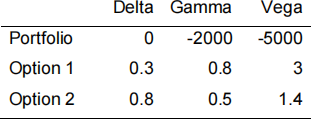ECOM055 – Risk Management for Banking Final Exam 2021/22
Hello, dear friend, you can consult us at any time if you have any questions, add WeChat: daixieit
ECOM055 - Risk Management for Banking
Final Exam 2021/22
Question 1
a) Explain why, viewed from the perspective of shareholders, the goal of corporate risk management is not to reduce or minimize risk. [8 marks]
b) Explain what ‘risk management failure’ is and provide one concrete example. [8 marks]
c) Explain why we regulate bank risk taking stricter than other financial institutions, such as hedge funds? [8 marks]
Question 2
a) Your sister-in-law has invested heavily in options with a strong Asian exposure, and she tells you that her portfolio has a positive delta. Give an intuitive explanation of what this means. Suppose the value of the stocks that your sister-in-law holds increases significantly. Explain what will happen to the value of your sister-in-law’s portfolio. [6 marks]
b) Consider a portfolio dependent on the price of a single asset that is delta neutral, with a gamma of −2,000 and a vega of −5,000.

What position in option 1, option 2, and the asset will make the portfolio delta, gamma, and vega neutral? [10 marks]
Question 3:
Consider 2 assets with a standard deviation of σ1 = 0.20 and σ2 = 0.3, and the correlation between the two assets ρ = 0.33.
a) Calculate the variance and the standard deviation of the portfolio if you combine the two assets into one portfolio. [6 marks]
b) Explain whether the risk measures “variance” and “standard deviation” are subadditive. Show this with a calculation. [10 marks]
c) Suppose that ρ = -1, is it possible to construct a portfolio consisting of a combination of the two assets with a variance of 0? Show your calculation. [10 marks]
Question 4
Turkey’s 1-year government bond CDS spread increased from 280 basis marks (8 August, 2018) to 540 basis marks (11th August, 2018). Suppose that the recovery rate of Turkish bonds is 40%, and the risk-free rate 3 percent (10 Year US Treasury Rate). Swap payments are made once a year, at the end of the year. Assume also that defaults take place at the end of the year.
Use the CDS pricing model discussed in class and calculate, using the CDS spreads, the implied default probabilities of Turkey on 8th August, 2018 and 11th August, 2018. Explain your answer. [10 marks]
Question 5
a) Suppose that a trader has bought some illiquid shares. In particular, the trader has 100 shares of A, which is bid $50 and offer $60, and 200 shares of B, which is bid $25 and offer $35. What are the proportional bid-offer spreads? What is the impact of the high bid-offer spreads on the amount it would cost the trader to unwind the portfolio? If the bid-offer spreads are normally distributed with mean $10 and standard deviation $3, what is the 99% worst-case cost of unwinding in the future as a percentage of the value of the portfolio? [10 marks]
b) Consider a commercial bank entering in a Repo transaction with an investment bank. The investment bank lends 90M dollar to the commercial bank in return for government bonds as collateral worth of 100M dollar. After 1-year, the commercial bank pays the investment bank 94.5 million and receives the 100M government bonds back. Calculate the repo interest rate and haircut. [6 marks]
c) Read the following new article fragment:
August 2, 2013 12:22 PM
RPT-Fitch: Wider ECB Haircuts Not a Serious Threat to Bank
Liquidity
By Reuters Staff
Planned revisions to haircuts on some collateral eligible for repo with the European Central Bank may reduce liquidity for some banks that hold a lot of retained covered bonds and those with large exposures to low investment-grade sovereigns, Fitch Ratings says.
But the collateral changes are not a major threat to their liquidity, especially as requirements were relaxed for other types of collateral, particularly asset-backed securities.
Explain why wider ECB haircuts may reduce liquidity for some banks [8 marks]
2023-08-26